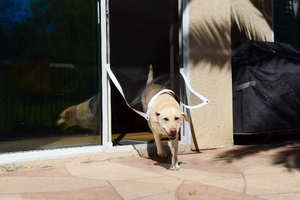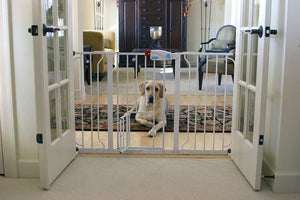Doors for Dogs Who Have Trouble Walking

A pet door allows your dog the independence to come and go on their own terms, freeing up your time spent playing ‘doorman’ to them. But what about dogs who struggle to walk? Can they enjoy the benefits of their own door too? Absolutely!
We’ll discuss what to look for in a pet door for a dog who has a hard time walking. Whether it’s arthritis and old age or another physical impairment, dog doors can be hard to navigate for a pet with limited mobility.
These are the most important things to look for when shopping for a pet door for a dog who struggles with walking:
- High Aspect Ratio Flap Size
- Low Step-Over
- Lightweight Flap
High Aspect Ratio Flap Size:
A “High Aspect Ratio” flap gives more height for a given width. For instance, while most pet doors increase in width as they increase in height, those with a high aspect ratio maintain a narrower width for taller flap sizes. This allows for a low step-over (which we’ll discuss below).
The best pet door with a high aspect ratio flap size is the Endura Flap. Endura Flap Pet Doors have a taller, narrower flap than the average pet door. This allows you to install the pet door as low as possible without losing flap height—perfect for dogs who have a hard time walking.
The Endura Door Mount and Endura Wall Mount are excellent options for a classic pet door look. The high-quality, weather-resistant flap keeps your home insulated year-round. Endura carries a variety of installation options such as the popular Thermo Panel 3e for sliding doors.
The high aspect ratio flap featured on all Endura doors also allows you to find a door that is tall enough to install nice and low to the ground, but not too wide—which adds unnecessary flap weight that can be challenging for old or arthritic dogs to navigate.
The Endura is the most weather-resistant pet door on the market. In turn, this means the flap is pretty heavy-duty. If the flap proves to be too heavy for your pet to push through, you can try adjusting the magnet strength for easier use.
Low Step-Over:
The Step-Over Height is the distance from the ground to the bottom of the pet door flap. For a pet who has a hard time walking, the lower the step-over, the better. Just as people struggle with stairs as they age, older pets can have a hard time stepping up to clear a high step-over.
The step-over should be no more than a third of your pet’s height from ground to shoulders for comfortable use their entire life. For a dog with mobility challenges, the lowest possible step-over is the way to go.
For door mounts, the lowest step-over possible that will maintain the integrity of the door is about 3” up from the floor. For wall mounts, the step-over can be as low as 1” for optimal comfort. As always, Measure Your Pet to ensure the proper fit.
Bonus: A low step-over allows your small dog to share the door too!
Lightweight Flap:
The Endura Flap is an excellent door for dogs who have a hard time walking as it has a high aspect ratio, which allows for a low step-over. However, if the flap proves to be too heavy even after adjusting the magnet strength, it’s worth considering a pet door with a light flap.
If your pet struggles with walking, chances are they are going to have a hard time with a pet door flap that is too heavy for them to push through. To avoid adding an additional obstacle, look for a pet door with a lightweight fap.
The Ideal Ruff Weather is a great door for older or physically impaired pets. The flap is light, yet insulating. Check out the Ruff Weather Wall Mount for a wall installation, which allows for an even lower step-over than the door mount.
For mild climates, the Ideal Deluxe Pet Door is another great option for dogs who have a hard time walking. The flap is light and comes in a variety of sizes so you can choose one that will allow you to install low to the ground for easy use. Check out some more installation options from Ideal Pet Products such as the Fast Fit Pet Door for sliding doors.

We hope this helped explain how to choose a pet door for your older or physically impaired dog. Once you’ve found the perfect door for your dog, check out our DIY Pet Door Installation Guide for installation tips and tricks.





Hi there!
I’m so happy to hear that you found this article helpful. Your pack sounds absolutely adorable, what a fun mix of pups! 😊
This is so helpful for pets out there with disabilities or other restrictions that don’t allow them to use a standard dog door!
We have a 1 yr old dog who injured his leg as a puppy and has a hard time bending his front leg. We previously used a dog door for our other 4 large breeds, but now we can’t use it because it’s too high for him to step over. He will get stuck trying to go through, despite his determination! I’m considering building a dog door that’s still tall but low enough to accommodate him, but I thought, there must be something out there for dogs like him! I found this article and it’s so helpful! Thank you! ❤️
Our pack: 3 generations of a Lab/Rhodesian Ridgeback mixed with “Double Doodle” (Labradoodle/GoldenDoodle), and a yellow lab, resulting in our puppy with the disability (a Lagoldridoodle? 🤷🏼♀️)! ❤️🐶